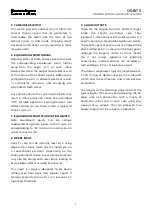
ORBIT 3
DOUBLE-SCROLL CHAOS OSCILLATOR
3
5 TAME/WILD SWITCH
This switch presents another way to affect the
kind of chaotic signals that are generated. In
mild mode, the orbits take the form of two
distinct scrolls. In wild mode, changing scrolls
becomes much easier, usually resulting in more
irregular orbits.
6 EQUILIBRIUM POINT KNOBS
Rotating either of these knobs clockwise moves
the corresponding equilibrium point further
away from the origin (0 V). As such, these
parameters affect the output amplitudes as well
as the nature of the chaotic signals. Additionally,
setting both points in different positions results
in asymmetric attractors, and changing one
point affects both scrolls.
Any combination of the system parameters may
result in stable oscillation (much like a standard
VCO), bistable operation (cycling between two
different orbits) or full chaos, which is typical of
chaotic systems.
7 EQUILIBRIUM POINT MODULATION INPUTS
Both equilibrium points can be voltage
modulated using these inputs, with 0 V and +5 V
corresponding to the minimum and maximum
values for each scroll.
8 RESET INPUT
Orbit 3’s core can be instantly reset by a rising
edge on this input, much like the ‘hard sync’ on
a conventional oscillator. Depending on the
chaos parameter values, the oscillation direction
may also flip during each reset pulse, leading to
octave down effects at audio frequencies.
This input is uniquely designed to be driven
reliably even from weak, slow, bipolar signals. It
features Schmitt action, with a +2 V low and +3 V
high logic threshold.
9 CHAOS OUTPUTS
These are the outputs from the different stages
inside the chaotic oscillator’s core. They
represent a three-dimensional orbit on axes X, Y
and Z around two adjustable equilibrium points.
The output signal of each successive stage will be
phase shifted by 60°, as shown on the front panel,
although the irregular nature of chaos means
this is not always apparent. For patching
convenience, inverted outputs are included as
well, yielding a full set of 6-phase outputs.
The output amplitudes typically range between
3 and 12 Vpp, as determined by the tame/wild
switch and the distribution and scroll position
parameters.
The images on the following page illustrate the
typical figures that arise when projecting the 3D
orbits onto two dimensions, with a variety of
parameter values and in each case using only
two out of six outputs. They are based on true
output captures of the module in operation.
Содержание ORBIT 3
Страница 4: ...ORBIT 3 DOUBLE SCROLL CHAOS OSCILLATOR 4...








